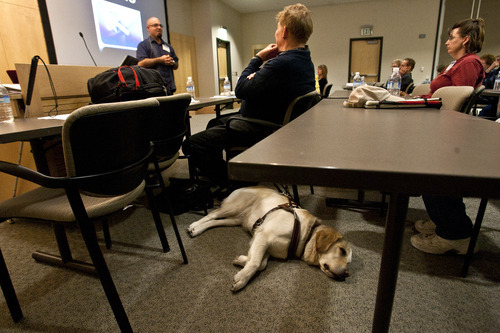This is an archived article that was published on sltrib.com in 2012, and information in the article may be outdated. It is provided only for personal research purposes and may not be reprinted.
Laura Lee Rough, like many individuals who have a visual impairment, wants to get the most out of the vision she has remaining. She has learned a few technological tricks to make her life easier through the years, but her eyes were opened wide Saturday during a presentation at the John A. Moran Eye Center in Salt Lake City.
Luis Perez told the crowd that "people with disabilities have the right to be creative. It is as important as any other right to me," said the University of South Florida doctoral student and avid photographer, who has just 10 degrees of vision. "Creating something allows you to find your self-expression, to find your voice and to empower yourself."
In this day and age, creativity — verbal, written and visual — often comes with the aid of computer technology and, once achieved, that creation is shared and spread through social media.
Perez's presentation focused on accessibility features on computers and iPhone, iTouch and iPad devices from Apple. Perez does not work for Apple, but his efforts to share his knowledge of the accessibility features and associated applications earned him the title of Apple Distinguished Educator.
One of the first things Perez did was introduce Alex and Samantha. Alex serves as the default voice for the VoiceOver program for all Mac desktop and laptop computers. Samantha is the default voice for iPhone, iTouch and iPad devices. Even Apple TV has VoiceOver.
Utilizing VoiceOver, visually impaired individuals can have Alex or Samantha read the items displayed on the screen. For those Mac users, VoiceOver can be activated by hitting the Command and F5 keys at the same time.
According to Perez, the popular Siri talking and listening phone assistant on the iPhone 4S could not have been developed without the work that was being done by Apple to create accessibility functions.
"It is a great example of how working on accessibility benefits everybody," he said.
Perez went on to show off other features like Zoom and Display under the Universal Access section of System Preferences. Functions are similar for all Apple products. The Universal Access area is not limited to serving people with visual impairments. There are also applications designed to serve people with hearing and eye-hand-motion impairments.
Rough, who has Usher syndrome and retinitis pigmentosa, explains her vision as "like looking through a keyhole." Although she has an Android phone, she was excited about Perez's presentation because she has many friends who use Apple computers and devices.
"I try to be involved in research to understand what I can do to maintain the vision I have left," said Rough, who was born deaf and diagnosed with Usher syndrome when she started to lose her vision in her early 20s. "It is about maintaining and maximizing resources and tools to go on in our everyday lives. That's why this is so great."
Rough snapped pictures, took video and compiled notes Saturday during all the presentations of the event arranged by the Foundation Fighting Blindness. She was posting pictures and thoughts from the presentations on Facebook before the speaker was done.
"We have a group with close to 3,000 people on Facebook, and I'm sharing what I'm learning today with them," she said. "This technology is so exciting for so many reasons. We can communicate with family and friends like everybody else does. People can get back into the media like they used to. We can do gaming, chatting, Facebook and Twitter."
The technologies Perez discussed allow people with disabilities to utilize social media, but the devices are also socially acceptable and usually cheaper than speciality devices used through the years.
"iPad is redefining, in so many ways, assistive technology," he said. "For me as an educator, the biggie is that it is a socially acceptable device — a cool thing everybody wants to have."
Perez said devices to help children with autism communicate can cost $8,000, but the iPad makes it possible to do that for about $700.
"It is a very portable device, and they are flexible. Everybody takes them everywhere and uses them for everything," he said. "We found that they are socially approachable. Once a kid with a disability gets an iPad, all the other kids want to come and play with them."
Apple Distinguished Educator
Luis Perez, of the University of South Florida, is recognized as an Apple Distinguished Educator for his efforts to educate the public about the accessibility applications available on Apple products. Perez has created resources for the variety of applications at a website — mobilelearning 4specialneeds.wikispaces.com — and through his blog, luisperezonline.com. Also, search for "Tech Ease 4 All" on iTunes. —
Walk for Vision
P The fourth annual Utah VisionWalk is being held at 10 a.m. June 16 at Sugar House Park. Participants help raise research money for retinal diseases. For information, visit http://www.fightblindness.org/UtahVisionWalk.



